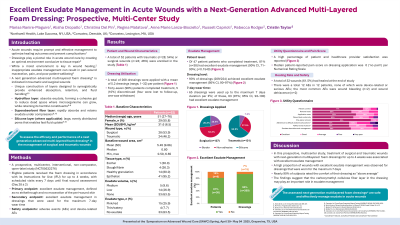Clinical Research
(CR-059) Excellent Exudate Management in Acute Wounds with a Next-generation Advanced Multi-layered Foam Dressing: Prospective, Multi-center Study
Friday, May 2, 2025
7:45 PM - 8:45 PM East Coast USA Time

Christina Del Pin, MD – Northwell Health; Marisa Ranire-Maguire, MD; Regina Matatova, MD – Northwell Health; Ann Marie Lanza-Bisciello, NP, RN, MSN – Northwell Health; Russell Caprioli, DPM – Northwell Health; Rebecca Rodger, BSc (Hons) – Convatec; Cristin Taylor, BS, DPT, MSHS – Convatec
Introduction: Acute wounds require prompt and effective management to optimise healing outcomes and prevent complications.1 Dressing play a pivotal role in acute wound care by creating an optimal environment conductive to tissue repair.2 Whilst a moist environment is key in wound healing,2 inappropriate exudate management can result in periwound maceration, pain and poor patient wellbeing.3 The aim of this study was to assess the efficacy and performance of a new advanced multi-layer foam dressing* in the management of surgical wounds and traumatic wounds.
Methods: A prospective, multi-center, interventional, non-comparator, open-label study of surgical and traumatic wounds, managed with either a border, silicone or non-adhesive version of a next-generation advanced multi-layered foam dressings.* Evaluation of the dressing and peri-wound skin occurred during dressing changes at study visits. Excellent wound exudate management was defined by a lack of strike-through and no maceration of the peri-wound skin. The effectiveness of the dressing when used for 7 days was assessed.
Results: Fifty-two patients (median patient age, 48.2 years) were included in the study, 53.8% of which had traumatic wounds, and 46.2% had surgical wounds. Five patients did not have their wound exudate analyzed. Of the 224 dressing changes, 209 (93.3%) were associated with excellent exudate management. Of the 15 dressings that were not associated with excellent exudate management, 14 exhibited strike-through alone, and one was associated with both strike-through and peri-wound skin maceration. Overall, 65/224 dressings were used up to the maximum duration per IFU (7 days ± 2 days). Of these, 63/65 (97%) had excelled in exudate management. Two dressing performance evaluations were associated with strike-through, one of which was also associated with maceration of the peri-wound skin.
Discussion: The results suggest that the next-generation advanced multi-layered foam dressings* are safe and effectively manage exudate in acute wounds.
Methods: A prospective, multi-center, interventional, non-comparator, open-label study of surgical and traumatic wounds, managed with either a border, silicone or non-adhesive version of a next-generation advanced multi-layered foam dressings.* Evaluation of the dressing and peri-wound skin occurred during dressing changes at study visits. Excellent wound exudate management was defined by a lack of strike-through and no maceration of the peri-wound skin. The effectiveness of the dressing when used for 7 days was assessed.
Results: Fifty-two patients (median patient age, 48.2 years) were included in the study, 53.8% of which had traumatic wounds, and 46.2% had surgical wounds. Five patients did not have their wound exudate analyzed. Of the 224 dressing changes, 209 (93.3%) were associated with excellent exudate management. Of the 15 dressings that were not associated with excellent exudate management, 14 exhibited strike-through alone, and one was associated with both strike-through and peri-wound skin maceration. Overall, 65/224 dressings were used up to the maximum duration per IFU (7 days ± 2 days). Of these, 63/65 (97%) had excelled in exudate management. Two dressing performance evaluations were associated with strike-through, one of which was also associated with maceration of the peri-wound skin.
Discussion: The results suggest that the next-generation advanced multi-layered foam dressings* are safe and effectively manage exudate in acute wounds.

.jpg)